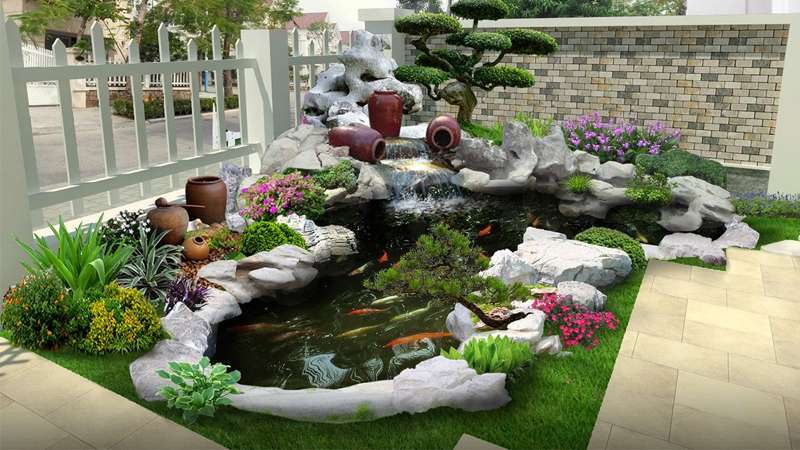Feng shui is a complex and diverse topic, encompassing not only the selection of land and door directions but also the water flow within your very own home. The following article will provide you with a deeper understanding of the feng shui of water flow into your home and the considerations to keep in mind. Let’s dive in!
1. Criteria for Installing Water Pipes for Good Feng Shui
Keep it Short, Safe, and Aesthetically Pleasing
Most of us tend to place water tanks on the rooftop, utilizing pumps to suction water up and distribute it through pipes for daily use.
Thus, it is essential to install pipes in a way that minimizes the distance between the tank and the pipes to increase water pressure and enhance pump efficiency.
According to the principles of the Five Elements and their interactions, where earth overcomes water, ensure that soil or sand does not mix with the water in the pipes. If the supply and drainage pipes are close together, position the supply pipe above the drainage pipe and install a water filter at the tank.
In the context of feng shui’s “Water Mouth,” the installed pipes should have two opposite directions for inflow and outflow.
 Constructing a garden pond
Constructing a garden pond
Creating a Water Accumulation Point
To accumulate positive feng shui energy, consider building a fish pond to attract prosperity and wealth. Be cautious when constructing an indoor rockery, as it may impact hygiene and mosquito breeding.
Ensure that the water pipes are frequently used and the drainage pipes are unobstructed. Avoid building a pond that is too deep, especially if young children are in the household, as it could pose a safety hazard.
According to feng shui masters, it is advisable to construct round or crescent-shaped water tanks, which belong to the metal element, or to create a curved shape that aligns with the water element, respecting the principle of the Five Elements’ interactions.
Selecting the Right Pipes for Effective Water Flow
In addition to a well-designed pipe system, choosing the right type of pipes is equally crucial. Opt for pipes that are of good quality and from reputable brands. Look for features such as heat resistance up to 100°C, high-pressure and impact tolerance, clean and safe water assurance, and longevity.
2. Taboos in Water Pipe Installation That Affect Feng Shui
Contaminants in the Domestic Water Supply
As mentioned earlier, according to feng shui principles and the concept of the Five Elements, where earth overcomes water, soil or sand should not be allowed to mix with the water in the pipes.
Feng shui experts also suggest that the left side of the house, represented by the Green Dragon, symbolizes mountains and hills, while the right side, represented by the White Tiger, is associated with water outflow. Therefore, water should enter from the Green Dragon side and exit from the White Tiger side.
Additionally, consider using stainless steel underground water tanks to minimize the entry of impurities and dirt into the water.
Placing the Water Tank at the Back of the House
It is believed that placing the water tank at the back of the house, which is considered the “backbone” of the house, is inauspicious. This arrangement can bring bad luck and hinder the family’s prosperity and smooth life.
 Feng shui-compliant water tank placement
Feng shui-compliant water tank placement
Positioning the Water Tank Below the Floor Level
This arrangement is considered dangerous from both a feng shui and a practical perspective. Building a basement that is as wide as the water tank can weaken the foundation and pose risks to the household members.
Therefore, opt for a stainless steel underground water tank instead of a traditional concrete one.
Installing the Water Tank Near the Entrance
Placing the water tank near the entrance creates an obstruction and makes movement difficult. During storms or strong winds, there is a risk of the water tank toppling and rolling, endangering the household members.
Positioning the Water Tank in the Peach Blossom Direction
The Peach Blossom direction is of significant importance to everyone, influencing family life and marital harmony. Placing the water tank in this direction can trigger the Peach Blossom煞, leading to disharmony and even marital breakdown.
Placing the Water Tank in the Noon Direction
According to feng shui, the noon direction represents the fire element, which is overcome by water. Violating this principle can result in health issues and disharmony within the family.
Positioning the Water Tank in the Cấn and Khôn Directions
The Cấn direction represents the northeast, and the Khôn direction represents the southeast. Placing the water tank in these directions creates a water-overcoming-earth scenario, leading to financial loss and health issues, particularly for women, children, and the elderly, who may suffer from respiratory and digestive problems.
To avoid this, place the water tank in the directions of Giáp, Bính, Tân, Quý, and Nhâm. Avoid the directions of Mậu and Kỷ, which belong to the earth element. Position the water tank at a square angle to the main door to attract wealth and good fortune.
We hope that this article has provided you with a deeper understanding of water flow feng shui and will guide you in making informed decisions regarding your home’s water system.
>>
>>
>>
2023 Lunar New Year Gift Ideas for Older Family and Friends
As 2021 approaches, families worldwide are gathering to celebrate the special bond between grandparents and their grandchildren. To show their love and admiration, these thoughtfully chosen gifts will bring a smile to the face of the elderly. Here, we have compiled a list of the 13 most meaningful Tet presents that can bring joy to our beloved grandparents.



































